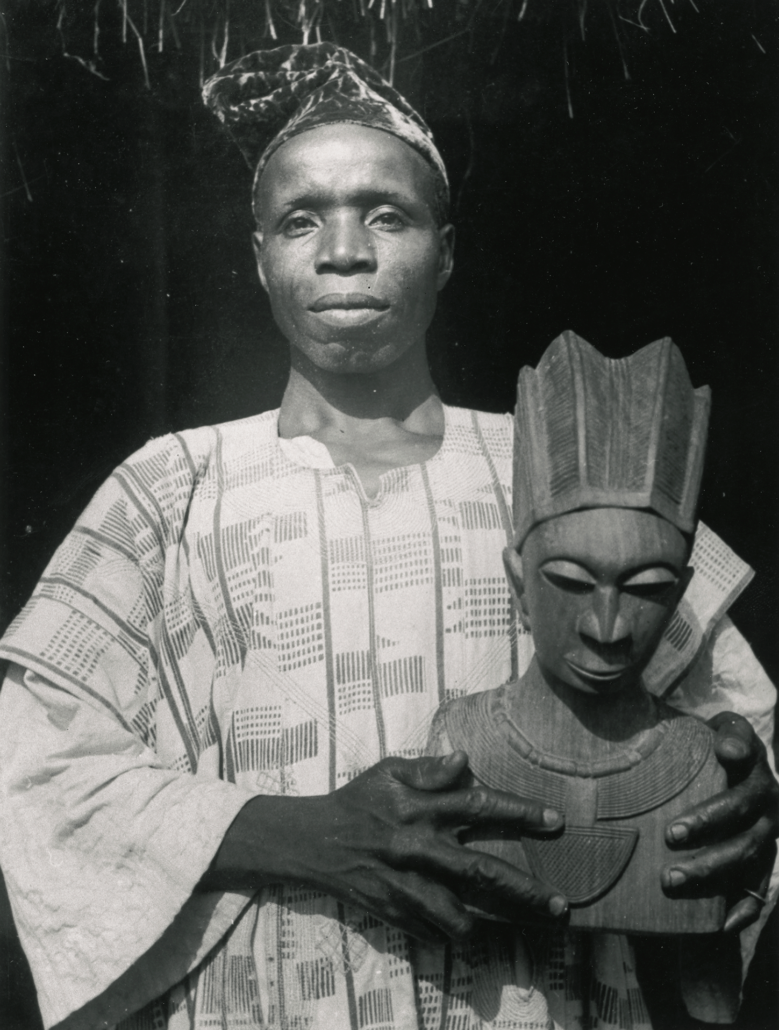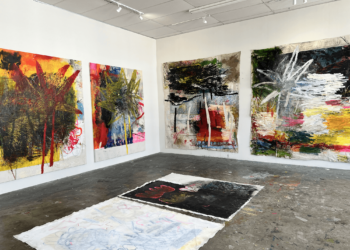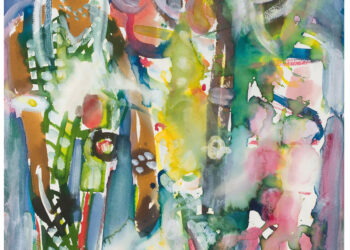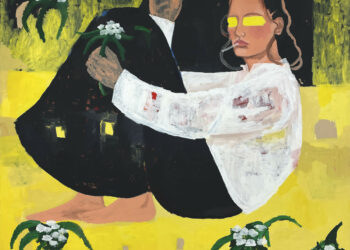The exhibition is a comprehensive examination of Nigerian sculptor Moshood Olúṣọmọ Bámigbóyè 50-year career

E. H. Duckworth, Moshood Olúṣọmọ Bámigbóyè Holding a Portrait Bust. Ìlọfà, Kwara State, Nigeria, ca. 1940. Danford Collection of West African Art and Artefacts, University of Birmingham, United Kingdom, inv. no. birrc-d432-1. © Research and Cultural Collections, University of Birmingham
This fall, the Yale University Art Gallery presents an exhibition of sculpture by the Nigerian artist Moshood Olúṣọmọ Bámigbóyè (ca. 1885–1975), reuniting masterworks housed in collections in the United States, Europe, and Nigeria. ‘Bámigbóyè: A Master Sculptor of the Yorùbá Tradition’ is a comprehensive examination of the artist’s 50-year career. Organised by James Green, the Frances and Benjamin Benenson Foundation Associate Curator of African Art at the Gallery, the exhibition is the first dedicated to Bámigbóyè – who is considered one of the greatest carvers of his generation – and presents him as part of a woodcarving tradition that flourished during a time of great societal upheaval in Nigeria. In addition to works by Bámigbóyè and other Nigerian woodcarvers of the period, textiles, ceramics, metalwork, and beadwork are on view, situating the artist’s workshop in relation to broader Yorùbá art and history.
“Bámigbóyè’s work is rooted in Yorùbá culture,” says Stephanie Wiles, the Henry J. Heinz II Director of the Gallery. “To gain a deeper understanding of his imagery and techniques, it was imperative to build relationships with the artist’s family in Nigeria as well as with cultural institutions in the country, especially the National Museum, Lagos, which has been a steadfast partner throughout the planning process. I am grateful to James Green and the rest of the project team for their commitment to this goal. The exhibition and catalogue have greatly benefited from the personal connections they made and the community-oriented scholarship they embraced.” In one example of this, as part of the development of the exhibition and publication, the Gallery and Yale’s Institute for the Preservation of Cultural Heritage have partnered with Nigeria’s National Commission for Museums and Monuments on a conservation training initiative, with the aim of creating an ongoing collaboration between Yale and the National Museum, Lagos.
The exhibition presents over 30 works by Bámigbóyè from different periods of his career, some of which retain the original pigment he used to decorate them. The artist is best known for the Ẹpa masks that he carved in the 1920s and 1930s for local religious festivals, and these form the centrepiece of the exhibition. Monumental in scale, the masks feature dozens of individually rendered figures that capture the busy world of early 20th-century Nigeria. His Ẹpa masks were so packed full of details that Bámigbóyè called one of them, depicting a ruler (ọba) on horseback, by the praise name “Atófòjọ́wò,” meaning “you can look at it for a whole day.” The Ẹpa masks are displayed alongside other sculptures, such as shrine figures, architectural elements from palaces, and commissions for colonial patrons carved in the 1940s and 1950s, which together track the development of his style over a 50-year period.
“Bámigbóyè was a legendary figure in the arts of 20th-century Nigeria,” comments Green. “A king, healer, and carver, he sought, through his art, to create an idealised portrait of the world around him and to thereby promote the health and peace of society. This exhibition expands the conversation around Bámigbóyè and his legacy in Nigeria today and is an opportunity to see all his major works displayed together for the first time.”
Bámigbóyè was the inheritor of an ancient tradition of Yorùbá woodcarving and part of a network of sculptors across Yorùbáland. To demonstrate the close relationship between his oeuvre and other contemporaneous art traditions, the exhibition also includes a selection of Yorùbá masterpieces in other media, including textiles, ceramics, and beadwork, as well as in other forms, such as crowns, fans, and drums. Both the exhibition and accompanying catalogue draw on field research, archival resources preserved in Nigeria and the United Kingdom, oral histories shared by permission of Bámigbóyè’s family, and the artist’s own oríkì, or oral praise poem. In the exhibition, new and archival photography, videos of interviews conducted with the artist’s community, and an audio guide featuring stories about him as told by his family combine to present a detailed and nuanced portrait of the artist.
Bámigbóyè was born in about 1885 in the Ìsálù family compound of Kájọlà, in the Òkè-Ẹ̀rọ́ Local Government Area of present-day Kwara State, and died at his home in Kájọlà in 1975. Part of a generation of Èkìtì Yorùbá woodcarvers who came of age during the first decades of British colonial occupation – formalised in 1900 – Bámigbóyè lived during a time of intense social, religious, and political change, which is reflected in his art. By the time of Nigerian independence, in 1960, Bámigbóyè was revered as one of the greatest living Yorùbá carvers. In the later years of his life, he was an increasingly important political and religious figure, and he is remembered by his family and community not only for his skill as a sculptor and a healer but also for his love of family and generosity of spirit.
The Gallery is grateful to the public and private collections that have graciously lent to the exhibition, including the National Museum, Lagos, part of the National Commission for Museums and Monuments, Abuja, Nigeria, as well as the British Museum, London; the Brooklyn Museum; the Cleveland Museum of Art; the Detroit Institute of Arts; Christophe Evers; the Metropolitan Museum of Art, New York; the Newark Museum of Art, New Jersey; the Seattle Art Museum; and the National Museum of African Art, Smithsonian Institution, Washington, D.C.
The exhibition will be on view from the 9th of September 2022 until the 8th of January 2023. For more information, please visit the Yale University Art Gallery.



